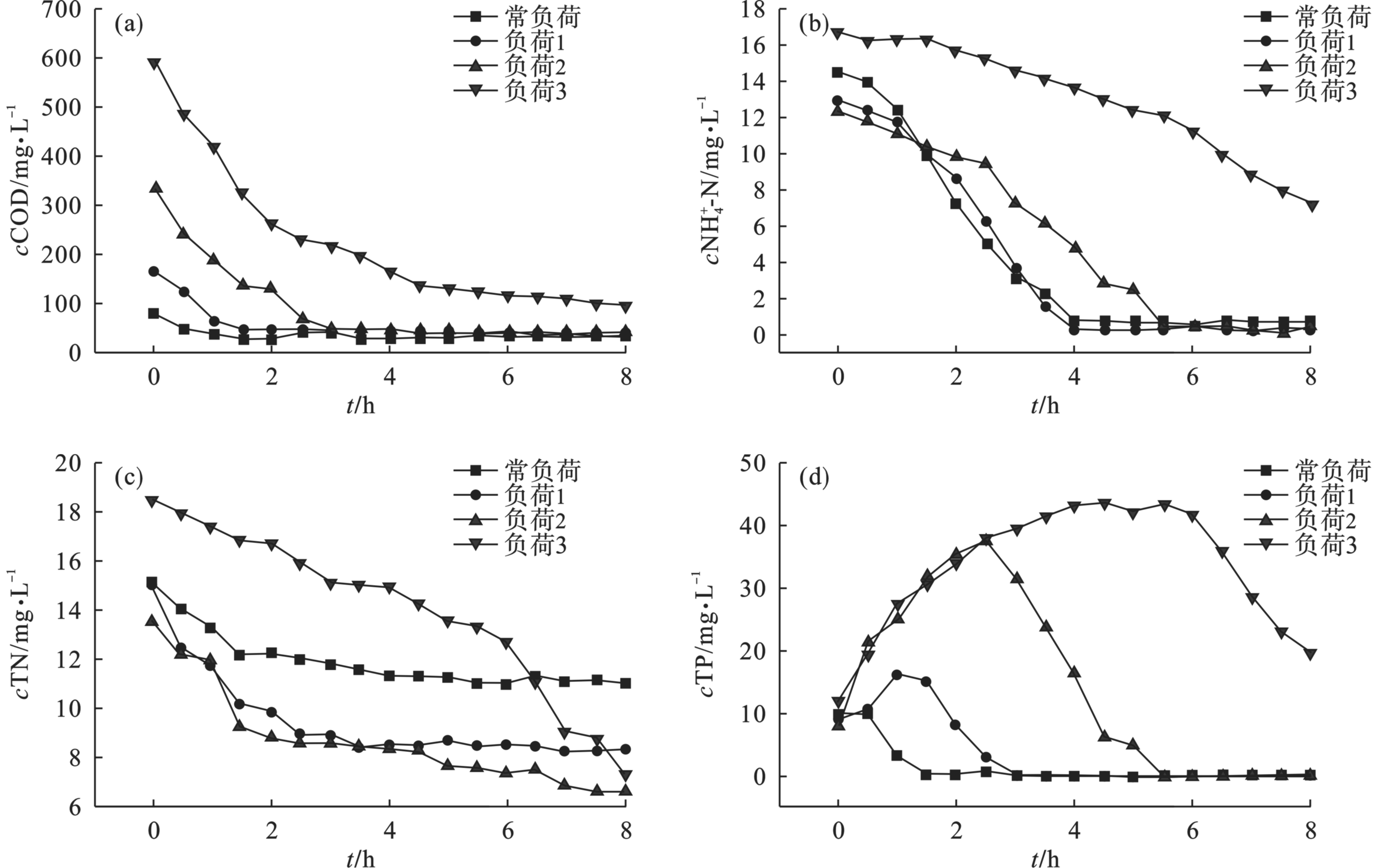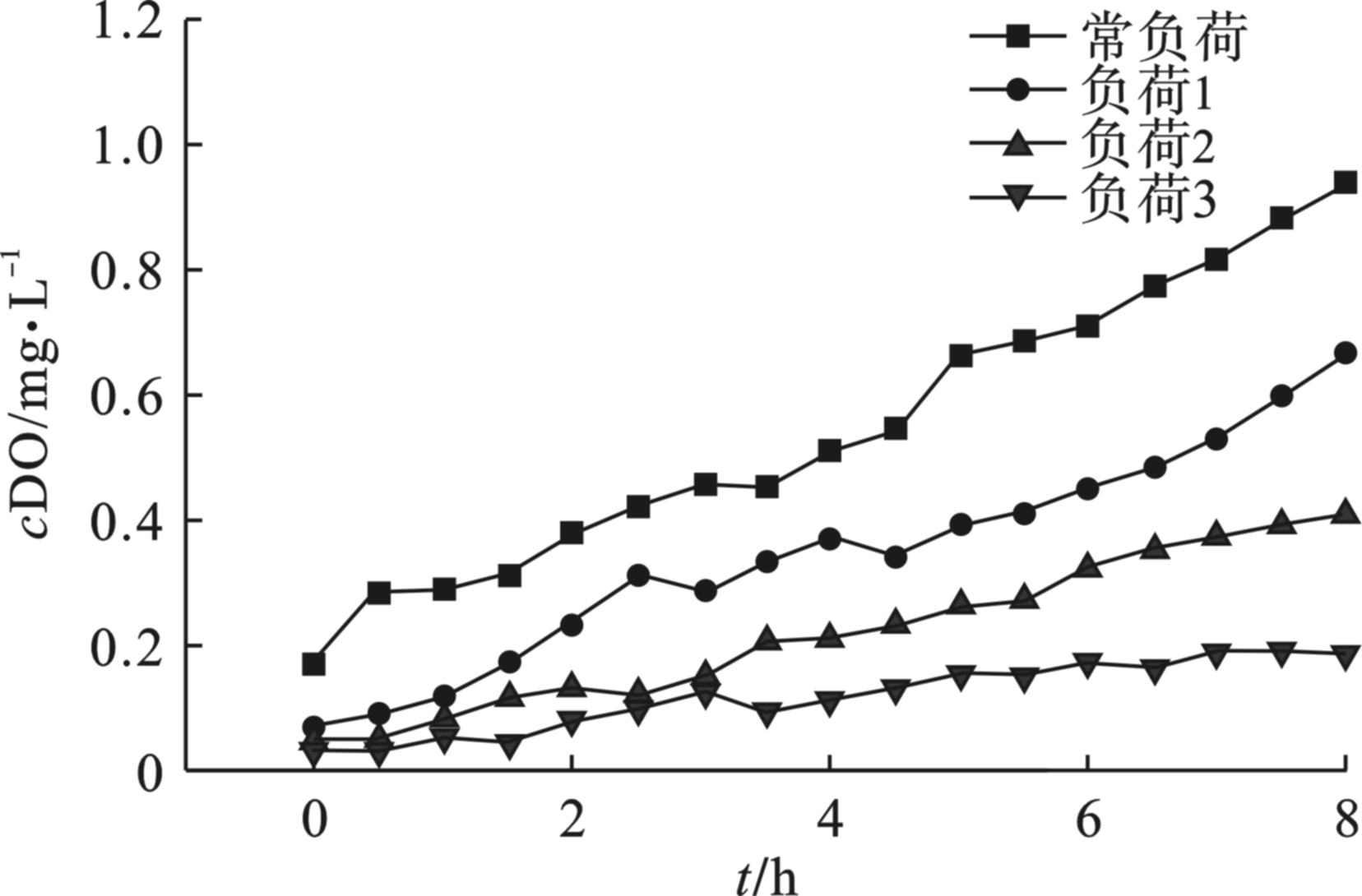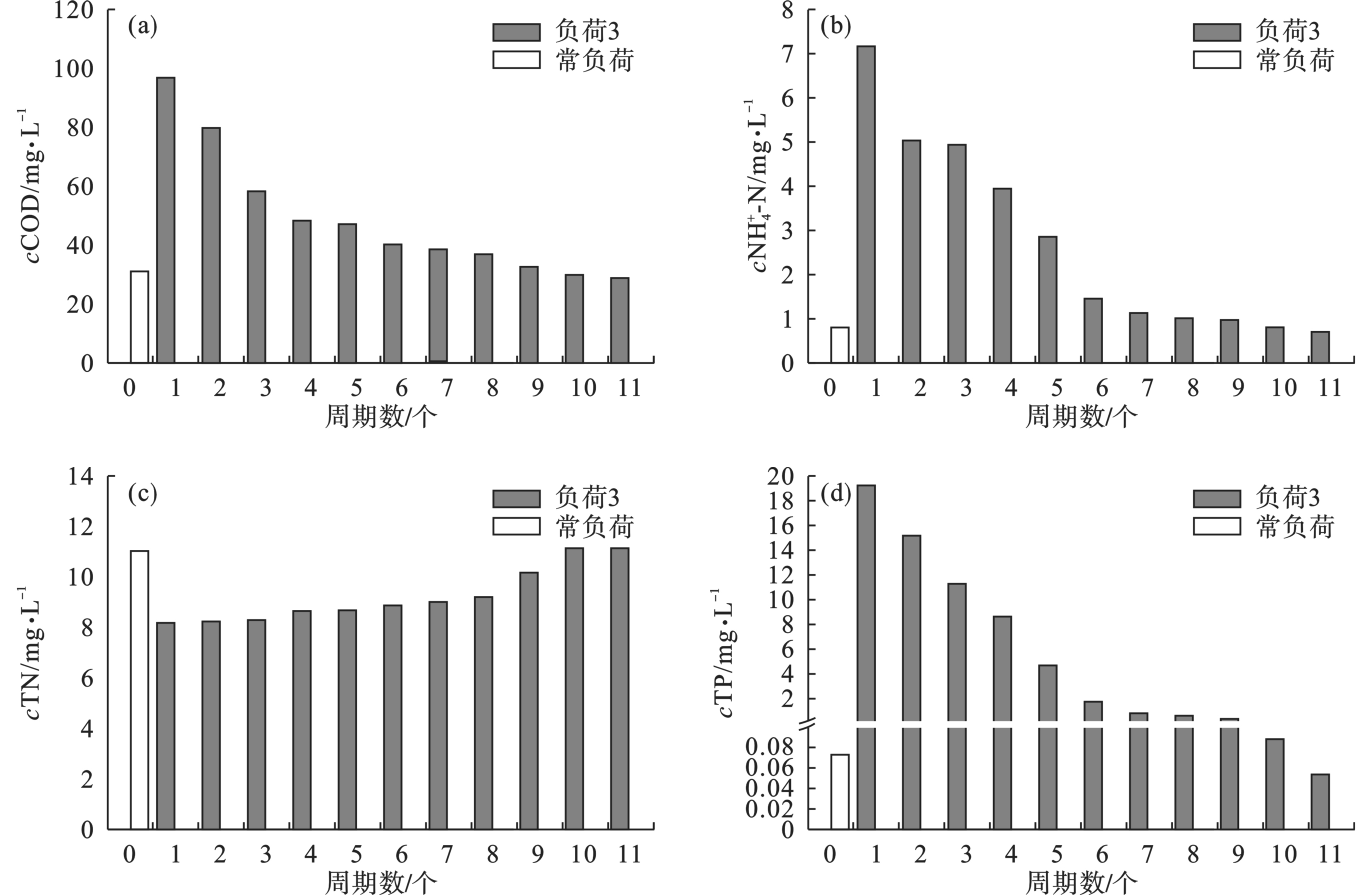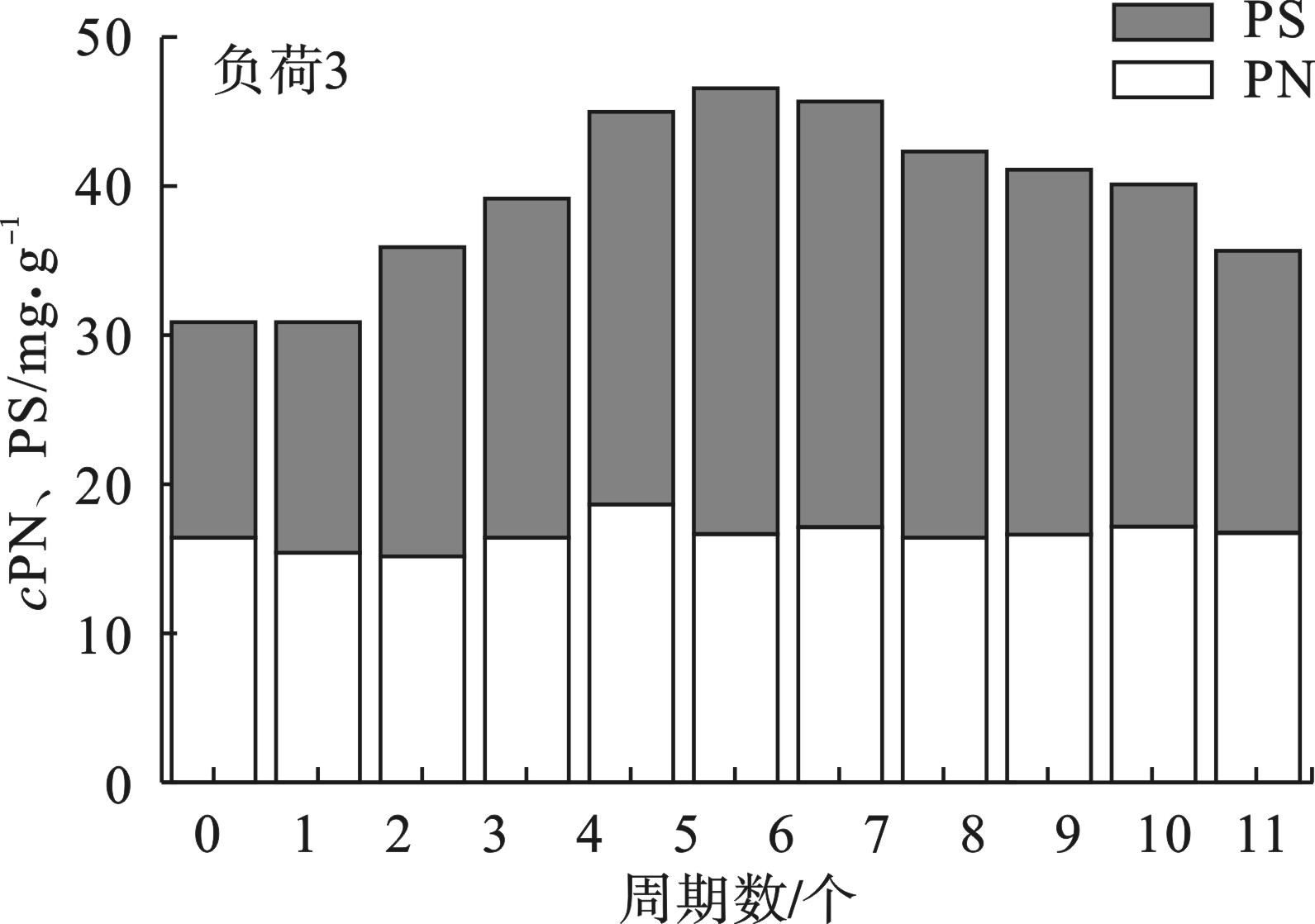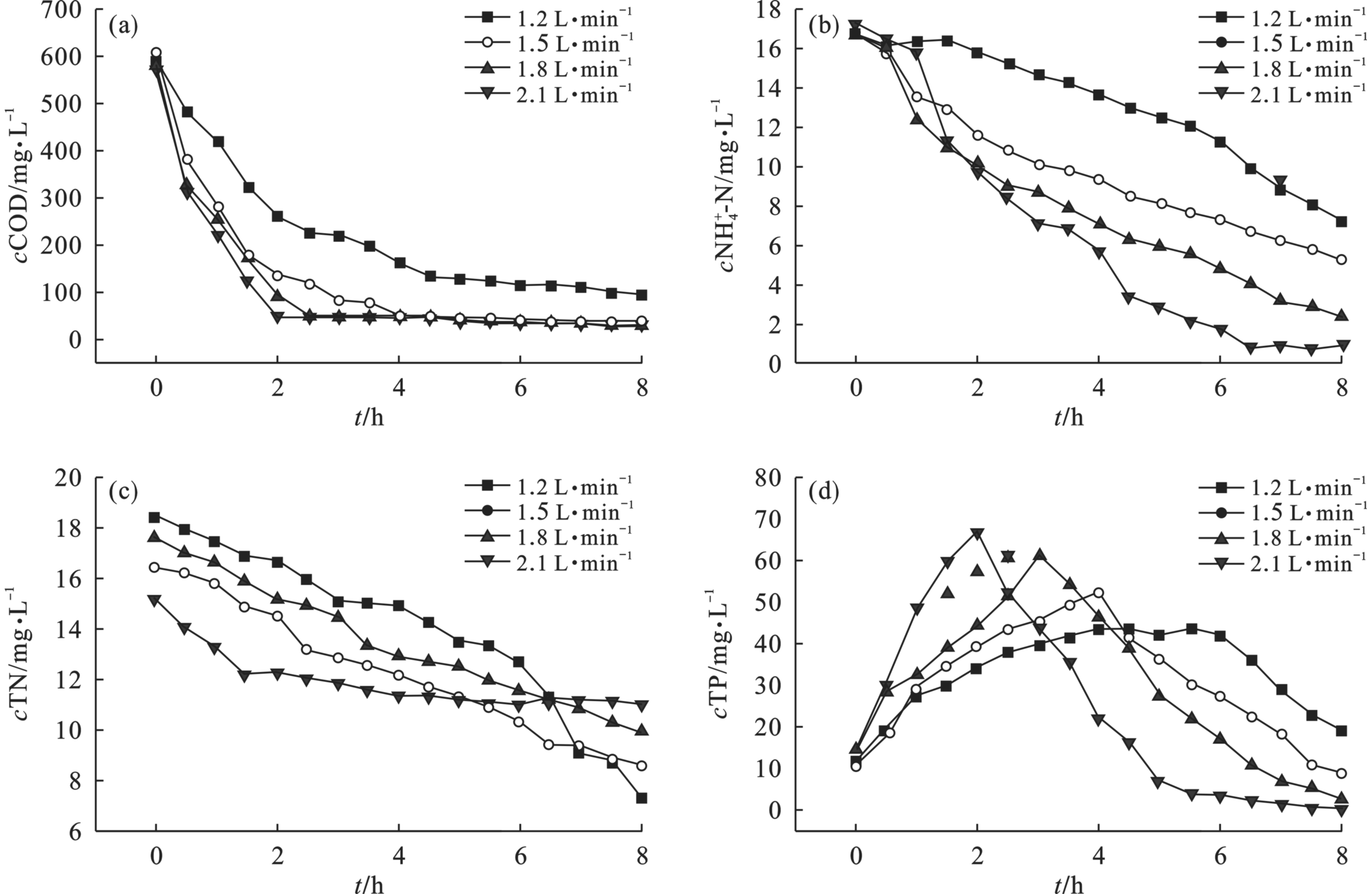-
我国城镇污水处理厂常年在实际运行过程中会遭受到有机负荷冲击[1-4],进水污染物浓度的突然变化或有机负荷(OLR)冲击会影响生化系统中微生物的生命活动、营养物质的利用及微生物代谢途径,进而影响水中污染物的去除效果[5-6]。我国城镇污水处理厂常用生物工艺为An/O、氧化沟、SBR和MBR等,An/O和SBR为城镇污水厂主要工艺[7],污水厂在运行的过程中常受高有机负荷冲击,生物系统遭受破坏且出水水质不达标,且高有机负荷冲击导致系统长时间处于低溶解氧状态,易造成污泥膨胀。因此如何采取有效的措施应对有机污染物冲击,保证出水水质稳定达标,对于实际工程应用价值更大。
董国日等[8]通过研究连续有机负荷冲击对SBR反应器的影响,当周期有机冲击负荷为0.10 kg COD/(kg MLVSS·h)时,SBR系统能够耐受连续多个周期的高有机负荷冲击。金明姬等[9]通过研究不同有机负荷条件下曝气时间对SBR反应器的影响,当搅拌/曝气时间分别为2.5 h/7.5 h时,COD和TP的去除效果最佳。本文通过改变进水有机负荷的大小,来了解不同有机负荷瞬时冲击对SBR反应器的影响,给出系统自然恢复时间。通过检测进出水COD、NH4+-N、TN、TP和活性污泥胞外聚合物(EPS),并采取提高曝气量的方法探索其对各项污染物的去除效果,以此为工程实践提供理论参数支持。
-
试验装置示意图,见图1。SBR反应器采用有机玻璃板制,300 mm×300 mm×400 mm,总有效容积为36 L。试验期间水温(21±1.5)℃。采用电磁式空气压缩机曝气,使用水泵进水,并用玻璃转子流量计进行气量控制。反应器运行方式:曝气8 h、沉淀3 h、排水10 min、闲置50 min,排水比50%。每个周期12 h,采用非限制性曝气方式。反应器活性污泥来自吉林省柏林水务集团污水厂。
-
实验污水模拟城镇污水主要成分:淀粉、牛肉膏、蛋白胨、乙酸钠(CH3COONa)、氯化铵(NH4Cl)、磷酸二氢钾(KH2PO4)、碳酸氢钠(NaHCO3)、硫酸镁(MgSO4)、氯化钙(CaCl2)、硫酸亚铁(FeSO4)和微量元素1 mL。其中微量元素成分:氯化锌(ZnCl2)、硫酸铜(CuSO4)、硫酸锰(MnSO4)和氯化铝(AlCl3)。实验期间进水污染物浓度,见表1。
-
冲击试验之前反应器已稳定运行30 d,运行期间曝气量1.2 L/min,混合液悬浮固体(MLSS)质量浓度3 500 mg/L,污泥龄30 d,运行期间平均出水COD、NH4+-N、TN和TP分别为28.9、0.43、10.46和0.083 mg/L。反应器运行稳定之后进行单周期瞬时有机负荷冲击试验,实验通过调整淀粉、乙酸钠的量来控制进水有机负荷大小。冲击过程中观察不同负荷下污染物去除变化和污泥特性,给出系统自然恢复时间并结合反应器出水效果给出相应的解决对策。反应器运行参数,见表2。
-
实验过程中MLSS采用重量法测定[10];COD采用重铬酸钾法测定;TN采用碱性过硫酸钾消解紫外分光光度法测定;NH4+-N采用纳氏试剂分光光度法测定;TP采用钼酸铵分光光度法测定;DO和温度用WTW(oxi3310)便携式DO仪检测测定;EPS采用甲醛-NaOH法提取[11];PN含量采用Folin-酚法测定[12];EPS中PS含量采用苯酚-硫酸法测定[13],PN和PS的含量以MLSS计,mg/g。
-
有机负荷对COD的降解。反应初期去除COD主要以物理吸附为主,活性污泥吸附量随着负荷的增加而增大。0~4 h期间常负荷、负荷1和负荷2基本完全降解,4~8 h期间COD处于平稳状态,出水COD分别为31.6、42.14和31.6 mg/L。0~8 h时负荷3在降解的过程中,随着降解时间的增加,COD的降解速度变慢,出水COD为96.32 mg/L。
图2(b)可知,NH4+-N完全降解的时间随着负荷的增加而增加,负荷3的NH4+-N出水浓度为7.205 mg/L,末端溶解氧偏低,硝化反应无法充分进行。图3(c)可知,常负荷、负荷1和负荷2出水TN为11.045、8.302和6.59 mg/L ,结合图2(b)和图3可看出硝化反应充分进行,不同负荷冲击下为反硝化提供了充足的碳源,且随着有机负荷的增加而增加;DO偏低为反硝化提供了良好的缺氧环境,且充足的碳源有利于异养菌的增长,使得反硝化反应充分进行。图2(d)可知,TP降解历时中,PAOs的释放量随着负荷的增加而增加,负荷1、负荷2和负荷3情况下的TP检测最大值分别为16.096、37.4和43.6 mg/L,3种负荷条件下出水TP分别为0.056、0.104和19.3 mg/L。负荷3的TP出水超高的原因是进水负荷的增加,高浓度有机物能使聚磷菌(PAOs)更好的生成聚羟基烷酸,厌氧释磷不受影响可以很好的进行[14]。PAOs在厌氧条件下得到充分的碳源,释磷时间也随之增加;导致好氧吸磷的时间较短,出水TP浓度过高,其次高负荷冲击下(图3),冲击过程中DO一直处在偏低状态,异养菌和硝化细菌争夺DO,硝化反应发生不完全。由于进水有机物浓度高、曝气时间短不利于硝化细菌的生长,而残留在反应器内的硝化反应产物硝态氮抑制PAOs厌氧释磷[15]。另外,PAOs也需在好氧条件下吸收磷来合成ATP,无法为好氧吸磷和硝化反应提供足够的溶解氧。试验结果表明,系统在OLR达到0.68 g/(L·d)时反应器出水不满足《城镇污水处理厂污染物排放标准:GB 18918—2002》的一级A标准。通过上述研究发现DO对冲击过程影响较大,因此决定加大曝气量增加DO来改善氧环境,探索增加DO对活性污泥系统抗OLR冲击缓解作用大小。
-
图4(a)可知,反应器经过4个周期COD出水达到48.19 mg/L,又经过7个周期自然恢复,恢复速率呈下降的趋势。第10个周期到第11个周期恢复速率逐渐平缓,且第11个周期时反应器出水28.67 mg/L,满足GB 18918—2002排放标准。
图4(b)可知,反应器经过3个周期NH4+-N出水4.964 mg/L,又经过3个周期自然恢复,恢复速率呈上升的趋势,在第11个周期时反应器NH4+-N出水达到0.682 mg/L。图4(b)和图4(c)可知,随着自然恢复期数的增长TN浓度也随之增长,NH4+-N浓度随之下降。原因是高有机负荷冲击下反应器溶解氧过低,硝化反应无法充分进行,高浓度有机物冲击下有利于异养菌的生长,且在低溶解氧条件下更有利于反硝化的进行。系统自然恢复的过程中随着周期数的增加,微生物得到充分的溶解氧,硝化反应进行充分,反硝化受到抑制造成硝态氮和亚硝态氮堆积,所以TN浓度也随之增高。图4(d)可知,反应器经过9个周期TP出水达到0.346 mg/L,又经过3个周期自然恢复出水达到0.054 mg/L,且自然恢复速率逐渐下降。原因是高有机负荷冲下,反应器在高浓度有机物条件下好氧异养菌与硝化菌以及PAOs争夺DO,抑制了PAOs好氧吸磷过程,恢复常负荷后PAOs得到充足的溶解氧且维持生命活动所消耗的有机物的量充足,通过自然恢复11个周期反应器出水TP满足城镇污水处理厂污染物排放标准。
-
EPS是活性污泥在一定条件下分泌的、包裹在胞外的高分子聚合物,主要成分为PS、PN等[16-18]。活性污泥在受到水质、水量的冲击条件下,EPS能对微生物起着保护作用。由于反应系统在负荷3的条件下系统出水不达标,因此通过检测冲击前后EPS含量来得出活性污泥系统自然恢复周期。负荷3冲击前PS和PN分别为16.62和14.62 mg/g,经过5个周期后PS达到最大值为30.17 mg/g,PN无较大变化,为16.48 mg/g,又经过5个周期后PS降至19.16 mg/g,EPS恢复至冲击前要需11个周期。负荷3时EPS恢复至起始时的含量,在恢复过程中,PS含量变化较大,PN含量变化较小,有机负荷较高的情况下,微生物无法利用全部碳源来维持新陈代谢,而是将过量的碳源转化为PS。系统自然恢复的过程中,高有机负荷冲击下促进系统产生大量的异养型微生物,PS又作为碳源被系统微生物利用而逐渐减少,见图5。
-
根据以上分析得出反应器在负荷3时脱氮除磷效率下降,主要原因在于高有机负荷冲击下反应器DO的不足,异养菌与硝化菌以及聚磷菌争夺DO,抑制了硝化作用和好氧吸磷过程。因此通过提高曝气量来解决高有机负荷冲击下反应器DO偏低的问题,并给出应对该问题的解决参数。
图6(a)可知,COD降解速率随着曝气量的增大而变快,曝气量分别为1.5、1.8和2.1 L/min,平均出水COD分别为39.66、28.25和31.59 mg/L。当气量增至2.1 L/min时,COD的降解速率相比于1.8 L/min时无变化。图6(b)可知,NH4+-N降解速率随着曝气量增加而增加,反应器得到充足的DO,硝化反应进行充分。在相同曝气时间时,出水NH4+-N浓度降低,曝气量分别为1.5、1.8和2.1 L/min时,平均出水NH4+-N分别为5.28、2.39和0.97 mg/L。图6(c)可知,气量越大TN降解速率越慢,原因是随着曝气量的增加反应器DO充足,厌氧时间缩短,不利于反硝化的充分进行。曝气量分别为1.5、1.8和2.1 L/min时平均出水TN分别为8.59、9.89和11.5 mg/L。图6(d)可知,随着曝气量的增加,PAOs得到充分的DO;厌氧释磷时间随曝气量增加而缩短。从图6中可以明显看到,不同的气量条件下磷的释放量也不同,气量越大磷的释放量相对越大,说明水中溶解氧越高,水力剪切力越大;把淀粉大分子物质分解成小分子糖类被PAOs储存,LIU et al [19]研究表明水力剪切力越大可促进PS分泌;因此PS也为厌氧释磷提供充足的碳源。当气量增至1.8 L/min时,反应器DO不足,硝化细菌和PAOs竞争反应器的溶解氧,此时DO不充足导致好氧吸磷无法充分进行。曝气量分别为1.5、1.8和2.1 L/min时平均出水TP分别为8.73、2.64和0.447 mg/L,提高曝气可使出水TP浓度降低。曝气量为2.1 L/min,污染物去除效率最高并且反应器出水达到城镇污水处理厂污染物排放标准。综合分析,负荷3下最适曝气量应为2.1 L/min。
-
(1)SBR活性污泥系统受单周期瞬时高浓度有机负荷冲击时,在0.68 g/(L·d)负荷条件下,反应8 h时的出水COD、NH4+-N、TN和TP分别为96.32、7.205、7.34和19.3 mg/L,不满足城镇污水处理厂污染物排放标准。DO不充足影响有机物的降解、硝化反应和好氧吸磷,且充足的碳源有利于反硝化和厌氧释磷进行。
(2)在0.68 g/(L·d)负荷条件下,系统冲击前PS和 PN分别为16.62和14.62 mg/L,冲击后EPS组分中PN含量无明显变化,PS含量经过11个周期自然恢复后;在第5个周期PS达到最大值。经过11个周期自然恢复后反应器出水COD、NH4+-N、TN和TP分别为28.67、0.682、11.12和0.054 mg/L满足GB 18918—2002排放标准,系统自然恢复至冲击前需要11个周期。
(3)瞬时有机负荷冲击导致反应器内DO不足,污染物去除效率降低的情况可采用提高曝气量的方式进行调控。在0.68 g/(L·d)负荷条件下,随着气量增加污染物去除效率提高,TN去除效率逐渐降低。通过调整曝气量的方式,在曝气量为2.1 L/min时,系统在0.68 g/(L·d)负荷条件下出水污染物满足污水处理厂污染物排放标准。
瞬时有机负荷冲击对SBR反应器的影响及调控措施
Effects of instantaneous organic load shock on SBR reactor and control measures
-
摘要: 为探究瞬时有机负荷(OLR)冲击对序批示活性污泥法(SBR)处理城镇污水的影响,进行了单周期瞬时高浓度OLR冲击试验,考察冲击时污染物去除效果及冲击前后胞外聚合物(EPS)组分及含量变化,并给出系统自然恢复的周期。通过调节曝气量的方式应对冲击,确定不同有机负荷条件下的最适曝气量。试验结果表明,系统在负荷达到0.68 g/(L·d)时出水COD、NH4+-N、TN和TP不能满足污水处理厂污染物排放标准。此时系统冲击前多糖(PS)和蛋白质(PN)分别为16.62和14.62 mg/g,冲击后EPS组分中PN含量无明显变化, PS含量经过11个周期自然恢复,在第5个周期PS达到最大值为30.17 mg/g,且反应器出水污染物能满足污水处理厂污染物排放标准。当有机负荷达到0.68 g/(L·d)时,系统最适曝气量2.1 L/min。Abstract: To explore the effect of transient organic load shock on the sequential activated sludge process (SBR) treatment in the urban sewage, a single period transient high concentration OLR shock test was carried out to investigate the effect of the pollutant removal and the changes of extracellular polymer (EPS) composition and content before and after shock, and the natural recovery period of the system was obtained. The optimal aeration volume under different organic load conditions was determined by adjusting aeration volume to cope with the shock. The experimental results showed that the effluent COD, NH4+-N, TN and TP cannot meet the pollutant discharge standards of the sewage treatment plant with the system load of 0.68g/(L·d). The polysaccharide (PS) and protein (PN) were 16.62 mg/g and 14.62 mg/g before the system with a shock, respectively. After the shock, the PN content in the EPS component did not change significantly. The PS content recovered naturally after 11 cycles, and the PS content reached the maximum value of 30.17 mg/g in the fifth cycle. And the effluent pollutants from the reactor could meet the pollutant discharge standards of the sewage treatment plant. When the organic load was 0.68 g/(L·d), the optimal aeration volume of the system was 2.1 L/min.
-
我国城镇污水处理厂常年在实际运行过程中会遭受到有机负荷冲击[1-4],进水污染物浓度的突然变化或有机负荷(OLR)冲击会影响生化系统中微生物的生命活动、营养物质的利用及微生物代谢途径,进而影响水中污染物的去除效果[5-6]。我国城镇污水处理厂常用生物工艺为An/O、氧化沟、SBR和MBR等,An/O和SBR为城镇污水厂主要工艺[7],污水厂在运行的过程中常受高有机负荷冲击,生物系统遭受破坏且出水水质不达标,且高有机负荷冲击导致系统长时间处于低溶解氧状态,易造成污泥膨胀。因此如何采取有效的措施应对有机污染物冲击,保证出水水质稳定达标,对于实际工程应用价值更大。
董国日等[8]通过研究连续有机负荷冲击对SBR反应器的影响,当周期有机冲击负荷为0.10 kg COD/(kg MLVSS·h)时,SBR系统能够耐受连续多个周期的高有机负荷冲击。金明姬等[9]通过研究不同有机负荷条件下曝气时间对SBR反应器的影响,当搅拌/曝气时间分别为2.5 h/7.5 h时,COD和TP的去除效果最佳。本文通过改变进水有机负荷的大小,来了解不同有机负荷瞬时冲击对SBR反应器的影响,给出系统自然恢复时间。通过检测进出水COD、NH4+-N、TN、TP和活性污泥胞外聚合物(EPS),并采取提高曝气量的方法探索其对各项污染物的去除效果,以此为工程实践提供理论参数支持。
1. 材料与方法
1.1 试验装置
试验装置示意图,见图1。SBR反应器采用有机玻璃板制,300 mm×300 mm×400 mm,总有效容积为36 L。试验期间水温(21±1.5)℃。采用电磁式空气压缩机曝气,使用水泵进水,并用玻璃转子流量计进行气量控制。反应器运行方式:曝气8 h、沉淀3 h、排水10 min、闲置50 min,排水比50%。每个周期12 h,采用非限制性曝气方式。反应器活性污泥来自吉林省柏林水务集团污水厂。
1.2 实验用水
实验污水模拟城镇污水主要成分:淀粉、牛肉膏、蛋白胨、乙酸钠(CH3COONa)、氯化铵(NH4Cl)、磷酸二氢钾(KH2PO4)、碳酸氢钠(NaHCO3)、硫酸镁(MgSO4)、氯化钙(CaCl2)、硫酸亚铁(FeSO4)和微量元素1 mL。其中微量元素成分:氯化锌(ZnCl2)、硫酸铜(CuSO4)、硫酸锰(MnSO4)和氯化铝(AlCl3)。实验期间进水污染物浓度,见表1。
表 1 设计进水主要污染物浓度范围mg·L−1 污染物 常负荷 负荷1 负荷2 负荷3 COD 372.1~427.3 798.2~811.2 1 116.3~1 281.9 1 484.8~1 709.2 NH4+-N 33.53~36.17 TN 38.53~41 TP 3.02~4.17 1.3 试验方法
冲击试验之前反应器已稳定运行30 d,运行期间曝气量1.2 L/min,混合液悬浮固体(MLSS)质量浓度3 500 mg/L,污泥龄30 d,运行期间平均出水COD、NH4+-N、TN和TP分别为28.9、0.43、10.46和0.083 mg/L。反应器运行稳定之后进行单周期瞬时有机负荷冲击试验,实验通过调整淀粉、乙酸钠的量来控制进水有机负荷大小。冲击过程中观察不同负荷下污染物去除变化和污泥特性,给出系统自然恢复时间并结合反应器出水效果给出相应的解决对策。反应器运行参数,见表2。
表 2 运行参数指标 常负荷 负荷1 负荷2 负荷3 曝气/L·min−1 1.20 1.20 1.20 1.50 1.80 2.10 污泥负荷/g·(L·d)−1 0.17 0.34 0.51 0.68 1.4 检测方法
实验过程中MLSS采用重量法测定[10];COD采用重铬酸钾法测定;TN采用碱性过硫酸钾消解紫外分光光度法测定;NH4+-N采用纳氏试剂分光光度法测定;TP采用钼酸铵分光光度法测定;DO和温度用WTW(oxi3310)便携式DO仪检测测定;EPS采用甲醛-NaOH法提取[11];PN含量采用Folin-酚法测定[12];EPS中PS含量采用苯酚-硫酸法测定[13],PN和PS的含量以MLSS计,mg/g。
2. 结果与分析
2.1 有机负荷冲击对污染物去除效果的影响
2.1.1 不同负荷下污染物去除效果
有机负荷对COD的降解。反应初期去除COD主要以物理吸附为主,活性污泥吸附量随着负荷的增加而增大。0~4 h期间常负荷、负荷1和负荷2基本完全降解,4~8 h期间COD处于平稳状态,出水COD分别为31.6、42.14和31.6 mg/L。0~8 h时负荷3在降解的过程中,随着降解时间的增加,COD的降解速度变慢,出水COD为96.32 mg/L。
图2(b)可知,NH4+-N完全降解的时间随着负荷的增加而增加,负荷3的NH4+-N出水浓度为7.205 mg/L,末端溶解氧偏低,硝化反应无法充分进行。图3(c)可知,常负荷、负荷1和负荷2出水TN为11.045、8.302和6.59 mg/L ,结合图2(b)和图3可看出硝化反应充分进行,不同负荷冲击下为反硝化提供了充足的碳源,且随着有机负荷的增加而增加;DO偏低为反硝化提供了良好的缺氧环境,且充足的碳源有利于异养菌的增长,使得反硝化反应充分进行。图2(d)可知,TP降解历时中,PAOs的释放量随着负荷的增加而增加,负荷1、负荷2和负荷3情况下的TP检测最大值分别为16.096、37.4和43.6 mg/L,3种负荷条件下出水TP分别为0.056、0.104和19.3 mg/L。负荷3的TP出水超高的原因是进水负荷的增加,高浓度有机物能使聚磷菌(PAOs)更好的生成聚羟基烷酸,厌氧释磷不受影响可以很好的进行[14]。PAOs在厌氧条件下得到充分的碳源,释磷时间也随之增加;导致好氧吸磷的时间较短,出水TP浓度过高,其次高负荷冲击下(图3),冲击过程中DO一直处在偏低状态,异养菌和硝化细菌争夺DO,硝化反应发生不完全。由于进水有机物浓度高、曝气时间短不利于硝化细菌的生长,而残留在反应器内的硝化反应产物硝态氮抑制PAOs厌氧释磷[15]。另外,PAOs也需在好氧条件下吸收磷来合成ATP,无法为好氧吸磷和硝化反应提供足够的溶解氧。试验结果表明,系统在OLR达到0.68 g/(L·d)时反应器出水不满足《城镇污水处理厂污染物排放标准:GB 18918—2002》的一级A标准。通过上述研究发现DO对冲击过程影响较大,因此决定加大曝气量增加DO来改善氧环境,探索增加DO对活性污泥系统抗OLR冲击缓解作用大小。
2.1.2 自然恢复下污染物去除效果
图4(a)可知,反应器经过4个周期COD出水达到48.19 mg/L,又经过7个周期自然恢复,恢复速率呈下降的趋势。第10个周期到第11个周期恢复速率逐渐平缓,且第11个周期时反应器出水28.67 mg/L,满足GB 18918—2002排放标准。
图4(b)可知,反应器经过3个周期NH4+-N出水4.964 mg/L,又经过3个周期自然恢复,恢复速率呈上升的趋势,在第11个周期时反应器NH4+-N出水达到0.682 mg/L。图4(b)和图4(c)可知,随着自然恢复期数的增长TN浓度也随之增长,NH4+-N浓度随之下降。原因是高有机负荷冲击下反应器溶解氧过低,硝化反应无法充分进行,高浓度有机物冲击下有利于异养菌的生长,且在低溶解氧条件下更有利于反硝化的进行。系统自然恢复的过程中随着周期数的增加,微生物得到充分的溶解氧,硝化反应进行充分,反硝化受到抑制造成硝态氮和亚硝态氮堆积,所以TN浓度也随之增高。图4(d)可知,反应器经过9个周期TP出水达到0.346 mg/L,又经过3个周期自然恢复出水达到0.054 mg/L,且自然恢复速率逐渐下降。原因是高有机负荷冲下,反应器在高浓度有机物条件下好氧异养菌与硝化菌以及PAOs争夺DO,抑制了PAOs好氧吸磷过程,恢复常负荷后PAOs得到充足的溶解氧且维持生命活动所消耗的有机物的量充足,通过自然恢复11个周期反应器出水TP满足城镇污水处理厂污染物排放标准。
2.2 有机负荷冲击对EPS的影响
EPS是活性污泥在一定条件下分泌的、包裹在胞外的高分子聚合物,主要成分为PS、PN等[16-18]。活性污泥在受到水质、水量的冲击条件下,EPS能对微生物起着保护作用。由于反应系统在负荷3的条件下系统出水不达标,因此通过检测冲击前后EPS含量来得出活性污泥系统自然恢复周期。负荷3冲击前PS和PN分别为16.62和14.62 mg/g,经过5个周期后PS达到最大值为30.17 mg/g,PN无较大变化,为16.48 mg/g,又经过5个周期后PS降至19.16 mg/g,EPS恢复至冲击前要需11个周期。负荷3时EPS恢复至起始时的含量,在恢复过程中,PS含量变化较大,PN含量变化较小,有机负荷较高的情况下,微生物无法利用全部碳源来维持新陈代谢,而是将过量的碳源转化为PS。系统自然恢复的过程中,高有机负荷冲击下促进系统产生大量的异养型微生物,PS又作为碳源被系统微生物利用而逐渐减少,见图5。
2.3 曝气量对有机负荷冲击的调控作用
根据以上分析得出反应器在负荷3时脱氮除磷效率下降,主要原因在于高有机负荷冲击下反应器DO的不足,异养菌与硝化菌以及聚磷菌争夺DO,抑制了硝化作用和好氧吸磷过程。因此通过提高曝气量来解决高有机负荷冲击下反应器DO偏低的问题,并给出应对该问题的解决参数。
图6(a)可知,COD降解速率随着曝气量的增大而变快,曝气量分别为1.5、1.8和2.1 L/min,平均出水COD分别为39.66、28.25和31.59 mg/L。当气量增至2.1 L/min时,COD的降解速率相比于1.8 L/min时无变化。图6(b)可知,NH4+-N降解速率随着曝气量增加而增加,反应器得到充足的DO,硝化反应进行充分。在相同曝气时间时,出水NH4+-N浓度降低,曝气量分别为1.5、1.8和2.1 L/min时,平均出水NH4+-N分别为5.28、2.39和0.97 mg/L。图6(c)可知,气量越大TN降解速率越慢,原因是随着曝气量的增加反应器DO充足,厌氧时间缩短,不利于反硝化的充分进行。曝气量分别为1.5、1.8和2.1 L/min时平均出水TN分别为8.59、9.89和11.5 mg/L。图6(d)可知,随着曝气量的增加,PAOs得到充分的DO;厌氧释磷时间随曝气量增加而缩短。从图6中可以明显看到,不同的气量条件下磷的释放量也不同,气量越大磷的释放量相对越大,说明水中溶解氧越高,水力剪切力越大;把淀粉大分子物质分解成小分子糖类被PAOs储存,LIU et al [19]研究表明水力剪切力越大可促进PS分泌;因此PS也为厌氧释磷提供充足的碳源。当气量增至1.8 L/min时,反应器DO不足,硝化细菌和PAOs竞争反应器的溶解氧,此时DO不充足导致好氧吸磷无法充分进行。曝气量分别为1.5、1.8和2.1 L/min时平均出水TP分别为8.73、2.64和0.447 mg/L,提高曝气可使出水TP浓度降低。曝气量为2.1 L/min,污染物去除效率最高并且反应器出水达到城镇污水处理厂污染物排放标准。综合分析,负荷3下最适曝气量应为2.1 L/min。
3. 结论
(1)SBR活性污泥系统受单周期瞬时高浓度有机负荷冲击时,在0.68 g/(L·d)负荷条件下,反应8 h时的出水COD、NH4+-N、TN和TP分别为96.32、7.205、7.34和19.3 mg/L,不满足城镇污水处理厂污染物排放标准。DO不充足影响有机物的降解、硝化反应和好氧吸磷,且充足的碳源有利于反硝化和厌氧释磷进行。
(2)在0.68 g/(L·d)负荷条件下,系统冲击前PS和 PN分别为16.62和14.62 mg/L,冲击后EPS组分中PN含量无明显变化,PS含量经过11个周期自然恢复后;在第5个周期PS达到最大值。经过11个周期自然恢复后反应器出水COD、NH4+-N、TN和TP分别为28.67、0.682、11.12和0.054 mg/L满足GB 18918—2002排放标准,系统自然恢复至冲击前需要11个周期。
(3)瞬时有机负荷冲击导致反应器内DO不足,污染物去除效率降低的情况可采用提高曝气量的方式进行调控。在0.68 g/(L·d)负荷条件下,随着气量增加污染物去除效率提高,TN去除效率逐渐降低。通过调整曝气量的方式,在曝气量为2.1 L/min时,系统在0.68 g/(L·d)负荷条件下出水污染物满足污水处理厂污染物排放标准。
-
表 1 设计进水主要污染物浓度范围
mg·L−1 污染物 常负荷 负荷1 负荷2 负荷3 COD 372.1~427.3 798.2~811.2 1 116.3~1 281.9 1 484.8~1 709.2 NH4+-N 33.53~36.17 TN 38.53~41 TP 3.02~4.17 表 2 运行参数
指标 常负荷 负荷1 负荷2 负荷3 曝气/L·min−1 1.20 1.20 1.20 1.50 1.80 2.10 污泥负荷/g·(L·d)−1 0.17 0.34 0.51 0.68 -
[1] 张莺, 周瑜, 何一俊, 等. 城市生活污水厂处理高比例工业废水时的运行探索[J]. 中国给水排水, 2013, 29(10): 95 − 100. doi: 10.3969/j.issn.1000-4602.2013.10.027 [2] 赵庆良, 王广智, 夏四清, 等. 小城镇水污染控制与治理共性关键技术研究与工程示范[J]. 给水排水, 2013, 49(11): 21 − 24. doi: 10.3969/j.issn.1002-8471.2013.11.004 [3] 熊磊, 边德军, 吴忌, 等. 长春市新区污水水质及水量变化规律分析[J]. 环境工程, 2017, 35(1): 36 − 40. doi: 10.13205/j.hjgc.201701008 [4] GOPALA KRISHNA G V T, KUMAR P, KUMAR P. Treatment of low strength complex wastewater using an anaerobic baffled reactor (ABR)[J]. Bioresource Technology, 2008, 99(17): 8193 − 8200. doi: 10.1016/j.biortech.2008.03.016 [5] WU B, YI S, FANE A G. Microbial community developments and biomass characteristics in membrane bioreactors under different organic loadings[J]. Bioresource Technology, 2011, 102(13): 6808 − 6814. doi: 10.1016/j.biortech.2011.04.012 [6] SPONZA D T. Investigation of extracellular polymer substances (EPS) and physicochemical properties of different activated sludge flocs under steady-state conditions[J]. Enzyme & Microbial Technology, 2003, 32(3/4): 375 − 385. [7] 艾胜书, 张焕楠, 王帆, 等. 城镇污水厂提标改造中生物处理工艺的研究与应用[J]. 环境生态学, 2019, 1(8): 53 − 55. [8] 董国日, 柳建设, 周洪波, 等. 连续有机负荷冲击对 SBR 系统的影响[J]. 中国给水排水, 2011, 27(13): 96 − 99. [9] 金明姬, 赵春子, 金承俊, 等. 不同有机负荷条件下曝气时间对SBR系统的影响[J]. 安徽农业科学, 2013, 41(2): 779 − 781. doi: 10.3969/j.issn.0517-6611.2013.02.114 [10] 国家环境保护总局. 水和废水监测分析方法[M]. 4版. 北京: 中国环境科学出版社, 2002: 210-284. [11] ADAV S S, LEE D J. Characterization of extracellular polymeric substances (EPS) from phenol degrading aerobic granules[J]. Journal of the Taiwan Institute of Chemical Engineers, 2011, 42(4): 645 − 651. doi: 10.1016/j.jtice.2010.11.012 [12] LUO J H, HAO T W, WEI L, et al. Impact of influent COD/N ratio on disintegration of aerobic granular sludge[J]. Water Research, 2014, 62: 127 − 135. doi: 10.1016/j.watres.2014.05.037 [13] ADAV S S, LEE D J. Extraction of extracellular polymeric substances from aerobic granule with compact interior structure[J]. Journal of Hazardous Materials, 2007, 154(1): 1120 − 1126. [14] 李捷, 熊必永, 张杰. An/O生物除磷中两个主要控制因素的研究[J]. 中国给水排水, 2004(12): 9 − 11. doi: 10.3321/j.issn:1000-4602.2004.12.003 [15] KIM D S, PARK Y S. Nitrogen and phosphorus removal characteristics by the variation of aeration time in SBR[J]. Journal of Environmental Health Sciences, 2009, 35(2): 116 − 123. doi: 10.5668/JEHS.2009.35.2.116 [16] SHENG G P, YU H Q, LI X Y. Extracellular polymeric substances( EPS) of microbial aggregates in biological wastewater treatmentsystems: A review[J]. Biotechnology Advances, 2010, 28(6): 882 − 894. doi: 10.1016/j.biotechadv.2010.08.001 [17] TIAN Y, HUANG J, ZHENG L, et al. Adsorption of Cd2+ and Zn2+ in water by extracelluar polymeric substances from waste activated sludge[J]. Journal of Nanjing University (Natural Sciences), 2006, 42(5): 543 − 548. [18] BADIREDDY A R, CHELLAM S, GASSMAN P L, et al. Role of extracellular polymeric substances in bioflocculation of activated sludge microorganisms under glucose-controlled conditions[J]. Water Research, 2010, 44(15): 4505 − 4516. doi: 10.1016/j.watres.2010.06.024 [19] LIU Y, TAY J H. The essential role of hydrodynamic shear force in the formation of biofilm and granular sludge[J]. Water Research, 2002, 36(7): 1653 − 1665. doi: 10.1016/S0043-1354(01)00379-7 -





 下载:
下载:
